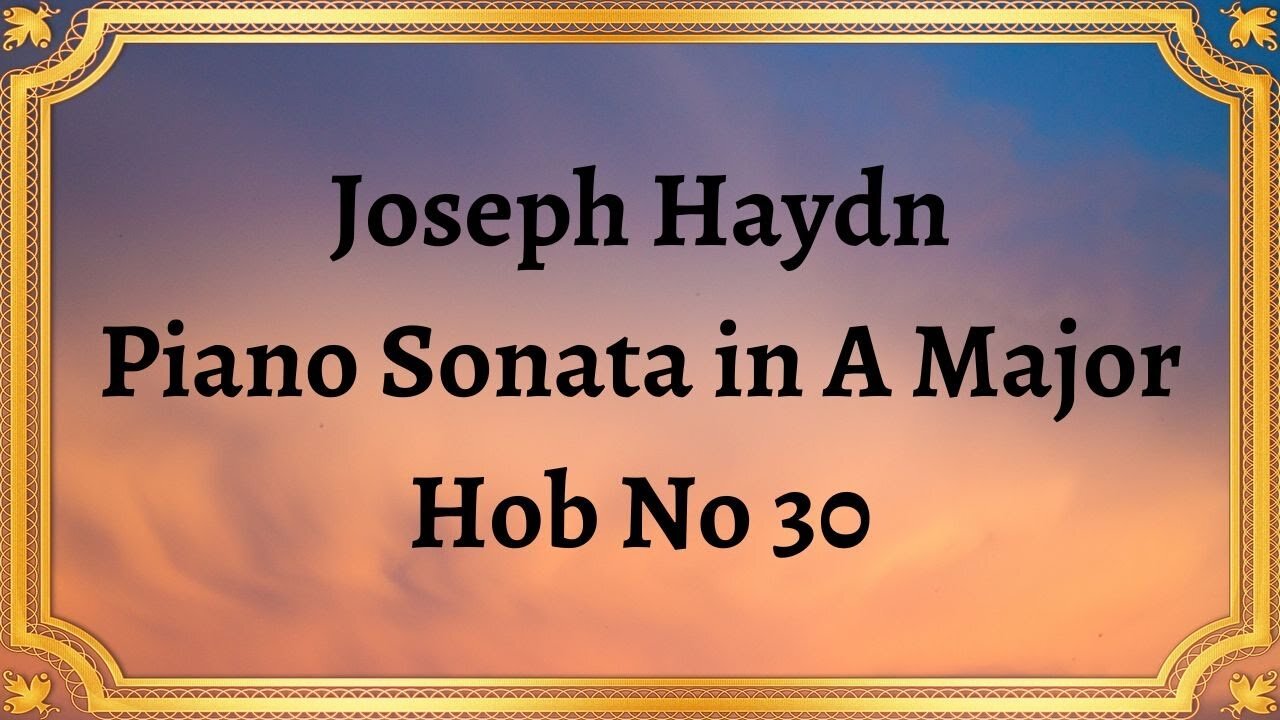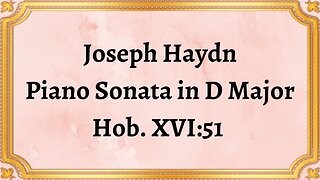Premium Only Content

Joseph Haydn Piano Sonata in A Major Hob No 30
#JosephHaydn #PianoSonata #AMajor #HobNo30 #classicalmusic #musiccomposition #melody #structure #emotionaldepth #harmonicchanges #musicform #virtuosity #humor #playfulness #Scherzo #PrestissimoFinale #musicanalysis #musictheory #musicappreciation #musiceducation #musicperformance #musicology #musichistory
Joseph Haydn's Piano Sonata in A Major, Hob No. 30 is a wonderful example of a classical-era piano composition. This masterpiece is part of a set of six piano sonatas he wrote between 1784 and 1785. The A Major sonata is the fifth of the set, and it has become one of the most popular piano sonatas written by Joseph Haydn.
The Piano Sonata in A Major is comprised of three movements: Moderato, Scherzo, and Adagio, followed by a Prestissimo Finale. In the first movement, Haydn demonstrates his mastery of melody and structure through the use of a simple yet captivating melody which is explored and developed over the course of the movement. The second movement, Scherzo, is notable for its use of syncopated rhythms, which gives the music a playful and rhythmic quality.
The third movement, Adagio, is characterized by its emotional depth and expressiveness, with its melancholic melodies and darker harmonies. This movement showcases Haydn's exceptional ability to convey deep emotional content through his music. The final movement, Prestissimo Finale, concludes the sonata with an exciting and virtuosic display of Haydn's musical skill.
The Piano Sonata in A Major is a technical and musical challenge for any pianist. The piece requires a high level of technical proficiency, with virtuosic scales and runs, precise articulation, and rapid shifts in mood and dynamics. Additionally, the sonata requires great musical sensitivity, with its complex and nuanced dynamic and harmonic changes.
Haydn was a master of musical form, and this sonata is an excellent example of his skill in this area. The piece adheres to the classical sonata form, with its distinctive structure of exposition, development, and recapitulation.
The Piano Sonata in A Major is also noteworthy for its use of humor, playfulness, and joy, which reflect Haydn's charming and witty personality. This playful tone is present throughout the piece, from the Scherzo's syncopated rhythms to the Prestissimo Finale's lively melodies.
In conclusion, Joseph Haydn's Piano Sonata in A Major, Hob No. 30 is a masterpiece of classical-era piano music. It showcases Haydn's extraordinary musical skill and creativity, as well as his remarkable ability to convey deep emotions through his music. The Piano Sonata in A Major remains one of the most beloved and frequently performed pieces in the classical piano repertoire.
You have the opportunity to support the channel https://destream.net/live/RadSiarAl/donate
-
 6:07
6:07
Classical music_Music Inspiration
14 days agoJoseph Haydn Piano Sonata in D Major, Hob. XVI:51
591 -
 1:53:47
1:53:47
Break The Cycle w/ Joshua Smith
1 day ago $0.39 earnedBreak The Cycle Ep. 246: The Return w/ Vinny Marshall
14.1K -
 53:09
53:09
Man in America
8 hours agoThe '3 White Killers' Making Americans Fat, Sick & DEAD w/ Food Chemist Stephen Talcott
24.4K7 -
 2:16:41
2:16:41
Tundra Tactical
4 hours ago $2.33 earnedThe Pew Pew Jew On Tundra Nation Live : The Worlds Okayest Gun Live Stream
36.8K4 -
 7:36
7:36
Colion Noir
8 hours agoDonald Trump Issues Executive Order To Protect The Second Amendment
62.1K44 -
 13:39
13:39
Exploring With Nug
13 hours ago $4.44 earnedCars Found Underwater While Searching Georgia Woman!
54.8K1 -
 56:50
56:50
IsaacButterfield
1 day ago $6.66 earnedSam Kerr Goes To Jail | Americas Worst Law | Teacher Of The Year
69.3K17 -
 6:14
6:14
Silver Dragons
1 day agoAmerican Silver Eagle Coins - Dealer Reveals Everything You NEED to Know
68K9 -
 19:18
19:18
Neil McCoy-Ward
1 day ago🚨 The USAID Scandal Goes Way Deeper Than We Could Have Imagined!
64.8K35 -
 14:29
14:29
Bearing
15 hours agoTHE BIG BALLS EFFECT - Democrats MELT DOWN Over DOGE & USAID 🔥
59.7K80